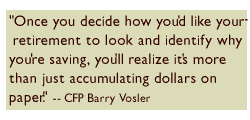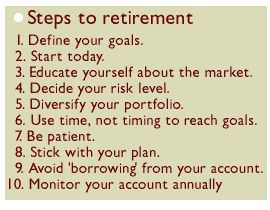|
Steps to financial freedom
|
 |
June 22, 2000: 8:25 a.m. ET
Take control of your long-term financial plan by following these suggestions
By Staff Writer Jennifer Karchmer
|
NEW YORK (CNNfn) - Whether you envision your retirement years lying on the beach sipping a cool drink, opening your own consulting business, or volunteering at the local nonprofit, you need a plan now.
Financial planners say by following these ten steps, you can take control of your investments. Assess how much risk you can handle, diversify your portfolio, and monitor it periodically so you can feel financially secure and glad that you got things started.
"Once you decide how you'd like your retirement to look and identify why you're saving, you'll realize it's more than just accumulating dollars on paper," said Barry Vosler, a certified financial planner from DeWitt, Iowa.

1. Define your retirement goals. Does retirement mean time to travel the world or spending your days with the grandkids? Or maybe you've been meaning to open your own fitness center or volunteer your time at the local soup kitchen?
However you imagine your golden years, now is the time to figure out how much money you'll need to achieve those goals. So first map out how you'd like to spend those days.
2. Start today. You just started that dot.com job after graduating college last year and retirement is the furthest thing from the your mind. Or maybe you're a baby boomer just starting a family and you've put off planning for years. Advisers say take the time now to start saving.
Contribute to your 401(k) plan at work, open an IRA and set some other savings aside in a mutual fund through automatic payroll deductions.
3. Educate yourself about the market. Stocks, bonds, the Nasdaq, "old economy," "new economy." What do all these terms mean?
Vosler suggests investors educate themselves about the markets and understand the cycles stocks go through, because the phenomenal bull market in the last ten years is not typical.

Investors in their 20s and 30s may be jaded because all they've experienced is a robust market with 20 percent returns that won't last forever.
"If someone has a handle on historical returns on the stock market, then you will understand what you can expect in normal market conditions," he said.
4. Decide your risk level. How much of your portfolio should be in risky investments such as emerging market or international funds? To answer these questions, evaluate the risks you take in daily life.
"When you drive down the Interstate, are you always driving the speed limit or do you push the limits a little bit?" Vosler said. "If you drive 90 miles an hour, then maybe you might be a more aggressive investor," and can devote more of your portfolio to equities or those riskier investments.
Check your mutual funds!
5. Diversify your portfolio. You've got a growth fund, a small-cap fund, an index fund and a value fund, so you think you've spread your investment risks around. But when you look more closely at each of the fund's holdings, you realize you're heavily weighted in technology stocks. If the Nasdaq takes a plunge like it did in mid-April, your entire portfolio could take a hit.
Advisers suggest you look closely at your funds' holdings and make sure your investments are diversified among sectors, countries, and security types such as stocks and bonds.
Click here to read CNNfn.com's new feature "Portfolio Rx," which looks at issues like asset allocation, diversification and portfolio rebalancing.
"If you're in your 20s, hooray if you're already thinking about retirement," said Claire Saunders, director of product development at Jones & Babson, which distributes Babson Funds. "Your diversification can tilt a little more toward aggressive investments. However, if you're a Baby Boomer you have to be more conscious of volatility because you have a shorter time period."
6. Use time, not timing to reach goals. We all know time is a relative thing, especially to younger investors who think they've got all the time in the world to start planning for retirement.
But by getting started today -- even if it's investing just a small amount -- you can take advantage of compound interest. Compound interest is when you earn interest on your principal as well as on interest you've earned in the past.
"You want a mutual fund investment to be a long-term investment and gain the advantage of compounding over time," Saunders said.
So even a one-time $10,000 investment that you never add to will continue to grow thanks to compounding.
7. Be patient. The purpose of a retirement plan is to be a long-term strategy, so don't expect to see results immediately. You'll see the market soar and dip -- remember, historically the stock market has experienced about 11 percent returns.
8. Stick with your plan. Pat yourself on the back once you've assessed your risk level, started contributing to your 401(k) and have a clear plan in sight. It's difficult to stay the course, especially when you see downturns, but be persistent and consistent in your investments.
9. Avoid "borrowing" from your account. Sure, saving is nice, but someday you'll need a down payment for that new car or money for a bigger house. Don't be tempted to dip into your nest egg.
Planners suggest you avoid borrowing or taking early withdrawals from your retirement accounts because of penalties and taxes. However, if you have nowhere else to turn, make sure you're well aware of the consequences and work with a tax adviser or financial planner.
Click here to learn more about borrowing from your 401(k)
"If you have to take out of an account for down payment on a house or car or child college tuition, remember that you took it out, and when you're at a point you can put it back in, you'll want to catch yourself back up," Saunders said.
10. Monitor your account annually.
It's easy to fall into the trap of checking your investments even hourly with today's technology and easy access over the Internet. But advisers suggest you keep your long-term investments long-term and review them annually, or maybe every six months.
"Paste them up on the wall but avoid reviewing them day to day because that will shake you out of the market," Vosler said. 
|
|
|
|
|
 |

|

